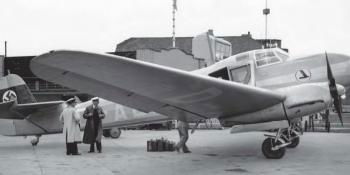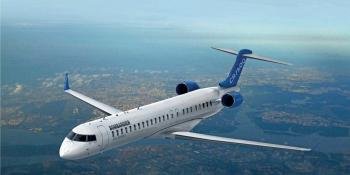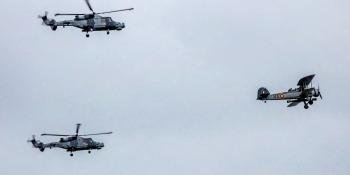Jan Kraak reports on the latest annual aerial refuelling exercise conducted by EC725 Caracalequipped EH 1/67 at BA120 Cazaux
. MILITARY EXERCISE DARK DUNE

Escadron d’Hélicoptères (EH) 1/67 ‘Pyrénées’ operates the EC725 Caracal from BA120 Cazaux in the South-West of France. It is one of the few Armée de l’Air units in the Commandement des Opérations Spéciales (COS) or special operations command. The squadron conducts difierent tasks with a particular focus on personnel recovery (PR) and special forces missions.
Since the last SA330b Puma left the squadron in 2017, the Caracal crews also have the search and rescue alert for a stretch of the Atlantic coast, roughly between the towns of Royan (south of La Rochelle) and Hendaye (near the Spanish border). The PR and special forces missions often take place over long distances or behind enemy lines. To ensure a suffcient radius of action, the Caracal is equipped for inflight refuelling; the Caracal’s maximum mission duration is restricted to 12 flying hours, which translates to a radius of approximately 1,000 nautical miles (1,850km).
Aerial refuelling
Aerial refuelling involves training pilots for specific competencies. Exercise Dark Dune, an annual event held at Cazaux and organised by EH 1/67, seeks to qualify younger pilots in the required competencies and allows those pilots with more experience to maintain their skills. Qualifications are not just an academic event for the French crews; the competencies are regularly put to use during ongoing operations. Two to four Caracals were deployed to Africa’s Sahel region in support of Opération Barkhane from June 2014 until late 2016, when they performed PR, SAR, intelligence, surveillance and reconnaissance (ISR) sorties, fly missions with special forces, transport or airdrop equipment in support of the Desert Battle Groups, and MEDEVAC French or allied troops. One of the problems of operating over the vast distances in the Sahel (an area of roughly 2,000 by 685 miles) is refuelling. Crews can refuel at airports and military installations when nearby but often end up refuelling from trucks acting as forward area refuelling points or FARPs.
However, the disadvantage of a FARP is the quantity of fuel required. Caracals need a fuel truck with suffcient capacity and enough troops to safely protect the open site during the refuelling process. Aerial refuelling removes the risks of a ground incursion and is undertaken above the threat zones presented by small-arms. It also saves a lot of time: a Caracal can take on between 150 and 250lb (330 to 550kg) of fuel per minute, which means a five to six-minute refuelling window.
The amount of fuel needed is typically discussed during the pre-flight briefing. Inflight, the crew sets the amount of fuel required, just as the operator in the US Air Force MC-130J Commando II sets the amount of fuel he or she can give away.
Once the designated quantity is off oaded or if the Caracal’s tanks are full, the transfer shuts off automatically. The first combat aerial refuelling mission between a French Caracal and an American MC-130J took place in October 2015 during an Operation Barkhane sortie involving two EC725s.
Caracal pilot Captain Mika expressed how notable the mission was because it was the first time that a Caracal was able to fly an eight-hour sortie. He said: “Even though we can theoretically fly longer it is very demanding in reality. You are wearing heavy combat gear in the heat and it’s physically very challenging. You learn a lot from these experiences’.
The squadron achieved another milestone in late 2015 when several Caracal pilots obtained the first night-time aerial refuelling qualifications during a Dark Dune exercise conducted with two MC-130Js assigned to 67th Special Operations Squadron, a unit from the 352nd Special Operations Wing, based at RAF Mildenhall, England.
The first night-time aerial refuelling during a combat mission took place in June 2016, once again with an American MC-130J.
Despite the squadron’s level of aerial refuelling experience, it is never a mundane activity, but one that is both stressful and technically demanding, especially during turbulence.
Explaining the effects of turbulence created by an MC-130J, Captain Mika said: “With refuelling pods positioned towards the tips of the wing, we don’t catch a lot of turbulence from the MC-130. However, because the propeller blades create an airstream that bends to the right, there is more turbulence behind the right wing, and you can always have bad weather’.

Pilots must concentrate on their task, which means the entire crew has to work together in order to have full situational awareness.
Captain Mika: “We cannot plug [the term used to describe making contact with the refuelling basket] two helicopters at the same time because of the close proximity to one another. One by one, each pilot moves his or her helicopter upwards and outwards into the refuelling position to plug’.
While the pilot focuses on the plug, the other crew members continuously check flight control data in the cockpit, radio transmissions, and visually the position of the Hercules and the other Caracal.
Captain Mika explained how a pilot must master close formation flying before being able to refuel. He said: “The challenge is that there are two moving elements. You have to maintain your position close to the Hercules but at the same time the basket, which also moves around. So when going for the plug, you are constantly keeping an eye out on both until the last moment when you focus on the basket. For refuelling, you need a certain finesse; you have to be precise and pilot smoothly’.
American dependence
Currently the Armée de l’Air does not have an aircraft with an aerial refuelling capability suitable for helicopters, which means it is dependent on the availability of Air Force Special Operations Command MC-130Js to carry out certain missions. This is not an ideal situation by any means because PR and special forces missions are often time-sensitive and have to be carried out at short notice. Having to contact an ally to request an aerial refuelling platform can take some time, which in turn might impact the mission. Consequently, the Armée de l’Air has stressed the need for a helicopter-capable aerial refuelling platform for years. Due to the well-documented delays and setbacks in the A400M programme, the Direction générale de l’armement (the French defence procurement agency) was forced to order two KC-130J Hercules on January 29, 2016. Until the Armée de l’Air KC-130Js become operational, the French will remain dependant on the availability of American MC-130Js.
However, this is likely to take a while, because the French KC-130Js should be delivered to the Armée de l’Air in 2019 after which some of the equipment will have to undergo operational testing. One aspect of the Armée de l’Air’s KC-130J acquisition that will not delay operational tasking is crew training. Why? Because the first regular C-130J was delivered to the Armée de l’Air last December, for which crew training is in part complete and ongoing, so the only requirement for the KC-130J will be qualification in aerial refuelling. According to Airbus, the A400M will eventually gain its Helicopter Air-to-Air Refueling (HAAR) capability but no specific timeline has been set.
In the past, Armée de l’Air Caracal crews also trained with Aeronautica Militare KC- 130Js from 46 Brigata Aerea based at Pisa Air Base, Italy. That training focused on basic refuelling procedures but has not taken place since the Italian HH-101 entered service. In recent years the Armée de l’Air has held several Dark Dune exercises at Cazaux with the participation of Air Force Special Operations Command MC-130Js from

Mildenhall. But the joint French-US training does not stop there. In November 2017, two Caracals were deployed to Arizona for Exercise Angel Thunder 17, and in March and April 2018 two helicopters deployed to Hulburt Field, Florida for a second-time participation in Exercise Emerald Warrior. Captain Mika explained: “We worked with US Special Forces and were able to qualify some pilots in aerial refuelling. We refuelled from an MC-130J and also an MC-130H, which was a first for us’.

Air Force Special Operations Command C-130 crews have a generic helicopter refuelling qualification, meaning they use exactly the same procedures for an HH-60 Pave Hawk or a Caracal. For Caracal pilots the differences between an MC-130H and an MC-130J are nominal, as Captain Mika explained: “Procedures are standardized so there are only slight differences between the different models of Hercules. They have different types of pod and the signals are therefore a little bit different, but in terms of piloting there are no significant changes’.


Latest edition
Dark Dune 2018-1 took place between April 16-19 during which one Mildenhall-based 67th SOS MC-130J operated from BA123 Orléans-Bricy. Regular training between the 67th SOS and EH 1/67 provides familiarity as Mika explained: “We are getting to know the pilots from Mildenhall pretty well, which makes it easier to work with them. We brief over the telephone, meet up at the designated spot, and debrief over the phone or via e-mail’.
On the first couple of days, EH 1/67 Caracal crews flew three daily sorties each with two aircraft, using a helicopter air refuelling track situated about five nautical miles off the coast near to Cazaux. Each Caracal pilot has to obtain their Hercules aerial refuelling qualification. This starts with a basic type rating, which includes at least six plugs to the left and right wing basket during a daytime sortie, seated in both the left and right side seat, which necessitates two sorties. Captain Mika described the left seat as more difficult because the pilot is not aligned with the refuelling probe and the basket.
Night-time qualification follows, which involves the same procedure as the daytime events; Caracal missions for Opération Barkhane were usually flown under the cover of darkness.
In general, one pilot requires one flying hour to qualify, and the qualification must be renewed each year, which allows a Caracal pilot to refuel from any C-130 Hercules; American, Italian or other. This year’s exercise was set up such in such a way that three pilots flew on board a Caracal during each qualifying sortie; one instructor pilot and two pilots.
Sortie articulation involved each Caracal pilot performing six plugs on the left and six on the right wing, the helicopter leaving the air refuelling track to change pilots, rendezvous with the MC-130J again and to start a second series of plugs: all with minimum voice communication. “We don’t really talk to each other. Everything is briefed beforehand, and once we meet up with the Hercules we use lights on the pods that signal when we are cleared to plug. Sometimes we use flashlights to signal each other. With night-vision goggles you can see just about everything, the only thing that’s sometimes hard to see during a very dark night are the white markers on the refuelling probe,” said Mika. Asked how the plane and helicopters meet up without radio communication, Mika said a rendezvous point located in the air refuelling track is used; the Caracal arrives there one minute before the planned time and the MC-130J will arrive one to two minutes later. The MC-130J passes over the helicopters after which the Caracal approaches the Hercules to start refuelling’.



Around 70% of EH 1/67 pilots are currently qualified for day and night-time aerial refuelling, as a result the scope of Dark Dune is expanding. “We have moved on from simply qualifying our pilots, and are now training to integrate aerial refuelling in operational missions. This is the goal for Dark Dune. The first few days are used for qualifying pilots, after which we fly complex mission scenarios in which aerial refuelling is just one of the elements. We will for instance fly a mission with four helicopters on the third day, which is already more complex as there are position changes between the helicopters. On the last day we take off after dark and head to the Captieux firing range, where we drop off and collect troops before flying back to Cazaux. The mission involved one aerial refuelling on the way to the range and one on the way back’.
This final sortie is only flown by qualified personnel and involves other participants that included an E-3F AWACS, Rafale fighters and an MQ-9 Reaper unmanned air vehicle. This event being a rehearsal for Dark Dune 2018-2, when the final mission will involve Caracal crews flying from Cazaux all the way to the Island of Corsica in the Mediterranean and back.
According to crews, EH 1/67 training activities are unlikely to change with the pending arrival of the first Armée de l’Air KC-130J, but operational reality will change because the KC-130J will allow the French to conduct autonomous long-range Caracal missions. Consequently, the Armée de l’Air will be able to respond quicker in fast-changing environments, retain more control over mission parameters with less paperwork, and no need for bilateral agreements. While the Armée de l’Air’s KC-130Js will eventually increase the effectiveness of EH 1/67’s Caracals, the support and training offered by the 67th SOS remains essential, and the relevance of Exercise Dark Dune will continue for some time to come.





